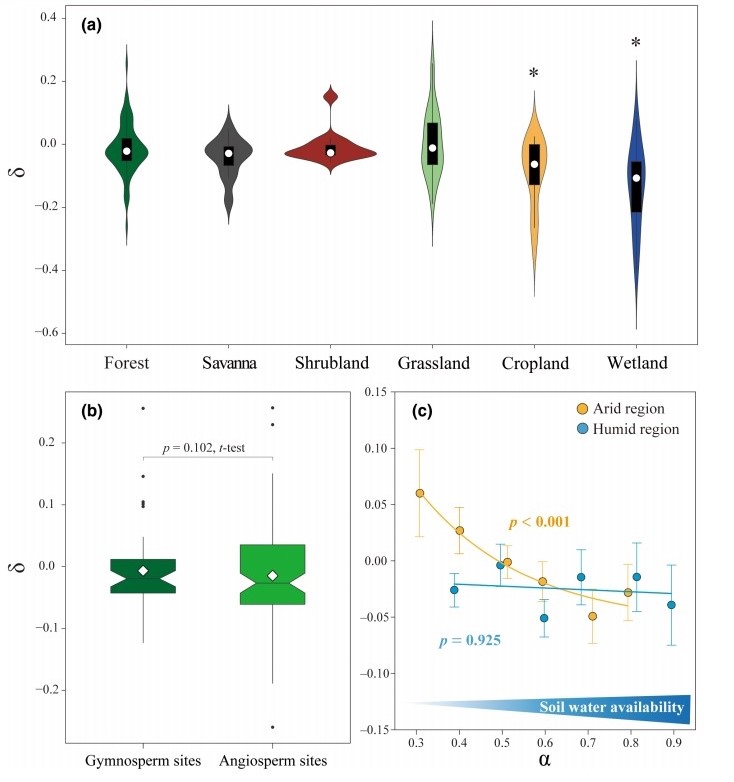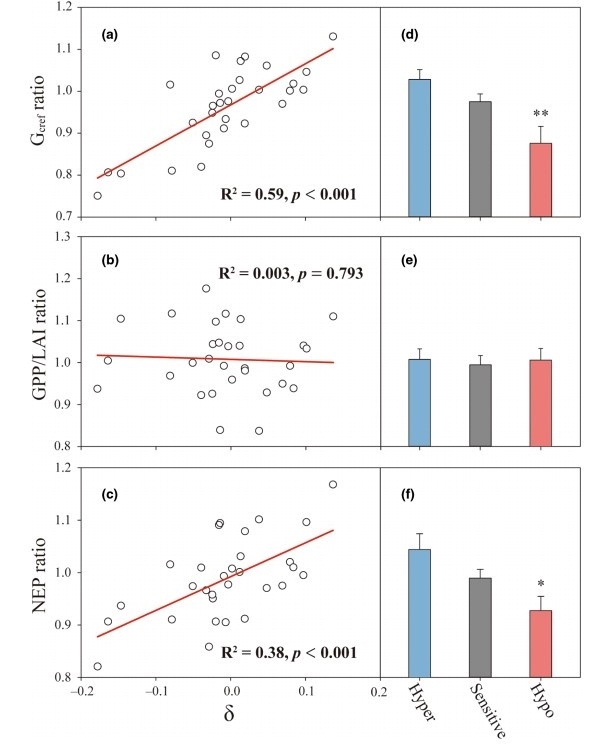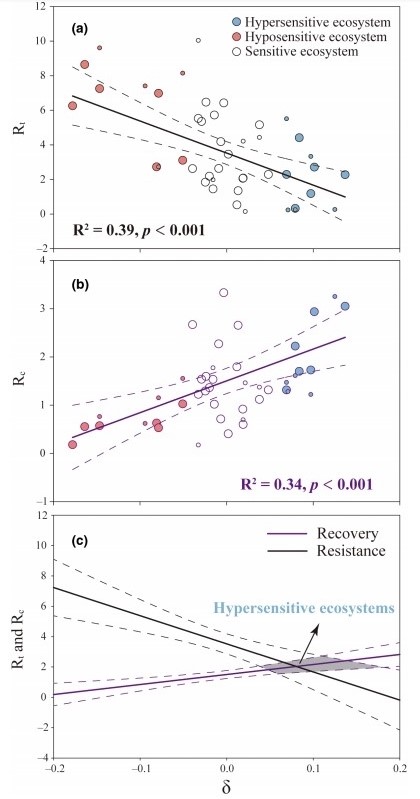随着气候变化不断加剧,全球植被面临着衰退和死亡的风险。因此,识别易受极端气候影响的生态系统类型,对于准确理解和预测未来植被的动态及分布至关重要。
气象干旱被认为是当前和未来影响陆地生态系统功能及其稳定性的主要威胁之一。许多研究表明,由饱和水汽压差(VPD)表征的大气干燥度对气孔行为和水力系统具有重要的影响,从而成为引发生态系统功能衰退的重要因素。因此,探索冠层导度(Gc)对VPD的敏感性以及气象干旱下生态系统固碳和耗水之间的权衡,不但可以评估生态系统在极端气候下的适应性,还可以更加全面地认识陆面-大气互馈过程。
植物的用水策略对于应对气象干旱至关重要。尽管植物的水力性状与其极端干旱下的抵抗力和恢复力密切相关,但目前缺少确切的证据表明与生态系统尺度水力特征相关的水分利用策略是影响干旱响应策略的重要机制。
一、研究方法
本研究利用全球通量观测、历史水文气象数据、遥感产品和植物功能性状数据,探讨了不同水分利用策略的生态系统对气象干旱的响应,并评估了它们在极端干旱下的脆弱性。本研究首次利用Gc对VPD敏感性经验值与理论值的偏差百分比(δ),评估了全球165个生态系统的敏感性,并根据δ定义了低敏感(hyposensitive)和高敏感的生态系统(hypersensitive),这种高敏感的生态系统反映出一种相比于等水势更为严格的水分利用策略。
二、研究结果
研究发现,在干旱地区,土壤水分不足的生态系统通常表现出保守的用水策略,但水分利用策略会随土壤水分可利用性的增加而趋于宽松;而湿润地区的生态系统表现出更明显的气候适应性,整体表现为较为宽松的水分利用策略。尽管低敏感和高敏感的生态系统在干旱期间的净生态系统生产力基本一致,但两类生态系统在结构和功能上采取了不同的策略。具体而言,在干旱期间,高敏感的生态系统会降低叶面积指数(LAI),通过提高光合效率维持固碳量;相比之下,低敏感的生态系统会保持LAI,通过维持叶片数量保持光合生产力,但这会导致水力系统一定程度的损伤,因此,无法像高敏感生态系统那样迅速地从干旱中恢复过来。总体而言,在大气-土壤干旱不断加剧的背景下,低敏感的生态系统面临着更大的退化风险。研究对干旱反应截然不同的生态系统有助于我们深入理解导致生态系统功能退化的过程,从而能够更准确地构建模型并预测气象干旱下生态系统的脆弱性。

Figure 1 Variation of the percentage bias of the empirical sensitivity to the theoretical value (δ) with vegetation types and soil water availability. (a) Violin diagrams show the distribution of δ for 165 ecosystems with various vegetation types. The hollow circle represents the median. The asterisk above the violins indicates the vegetation type in which there was a significant difference at the significance level of 0.05 between the empirical m/Gcref and the theoretical ratio. (b) Boxplots show δ for gymnosperm-dominated (dark green, N = 42) and angiosperm-dominated (green, N = 38) woody ecosystems. Notches approximate the 95% confidence interval for the median, and whiskers extend to the highest and lowest values within 1.5 times the interquartile range (IQR) of the upper and lower quartiles. The diamond in each box is the mean value. N is the number of sites in each classification. (c) Relationship between δ and mean soil water availability (i.e. α) in humid regions (δ = –0.017α – 0.014; R2 = 0.03) and arid regions (δ = –0.06 + 0.40e–3.99α; R2 = 0.95), respectively, for all study sites except croplands and wetlands. δ values were binned into 0.1 α increments. The error bar is the standard error in each bin.

Figure 2 Relationships between anomalies (z-score) of (a) growing season Gcref, (b) GPP/LAI, and (c) NEP during the drought year and the drought intensity (i.e. the absolute value of SPEI-12) for the hypersensitive (blue) and hyposensitive ecosystems (red) experiencing meteorological droughts, respectively. Each dot represented a drought year for a specific site. If an ecosystem experienced two or more drought years, the most severe one was chosen for the regression analysis; the rest were regarded as repeated measures shown by smaller circles but not included in the regressions.

Figure 3 (a-c) Relationships between δ and the ratio of growing season Gcref, GPP/LAI, and NEP of the year following a drought year to the multi-year means of non-drought periods for woody ecosystems experiencing droughts, respectively. (d-f) The mean values of the ratios for hypersensitive (Hyper, blue) and hyposensitive ecosystems (Hypo, red), with proportionately sensitive ecosystems for reference (Sensitive, gray). The error bar indicates the standard error. "*" and "**" above bars indicate the significance of the difference from unity at the level of 0.05 and 0.01, respectively.

Figure 4 Relationships between δ and (a) ecosystem resistance (Rt), (b) ecosystem recovery (Rc), as well as (c) their fitted regression lines for the woody ecosystems experiencing droughts. The range between the two dashed lines indicates the 95% confidence interval. Smaller circles represent repeated measures (i.e. drought years) for sites experiencing multiple drought years but were not included in the regression analyses.
本研究成果以“Hyposensitive canopy conductance renders ecosystems vulnerable to meteorological droughts”为题,于2023年1月在全球变化生态学领域顶级期刊Global Change Biology(IF=13.211)上在线发表,北京林业大学青年教师许行为第一作者,北京林业大学张志强教授和美国杜克大学Ram Oren教授为共同通讯作者。该研究得到了国家“十四五”重点研发计划(2022YFF1302501)和国家自然科学基金(31872711)的资助。
文章链接:http://doi.org/10.1111/gcb.16607
作者:许行 审核:张会兰 编辑:汪海娇